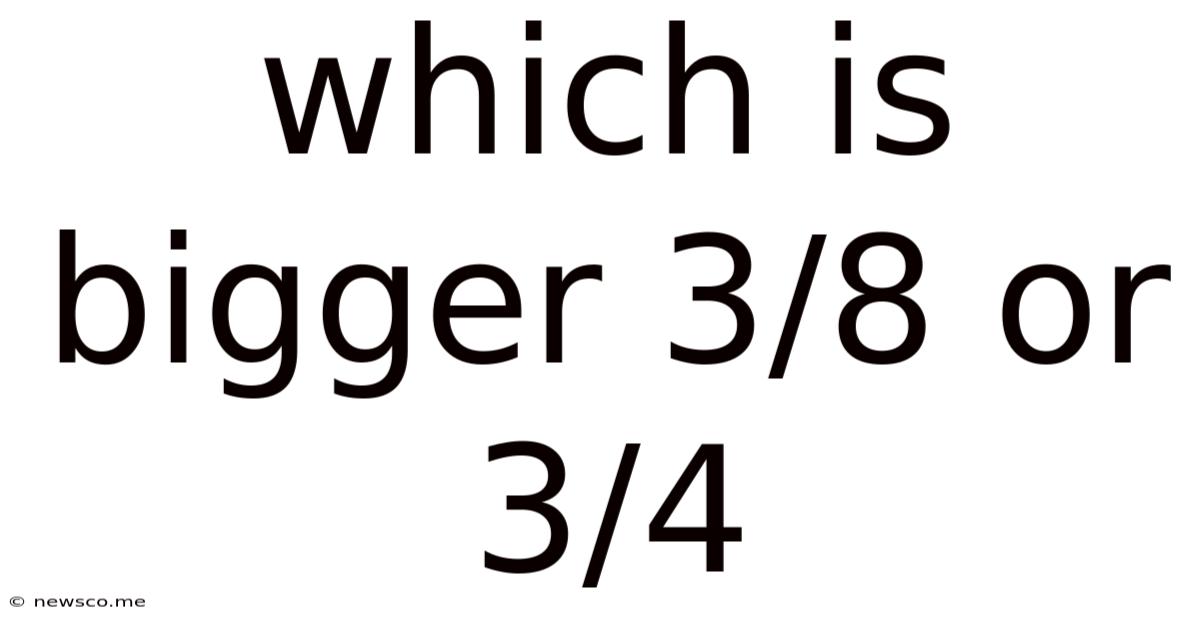Which Is Bigger 3/8 Or 3/4
News Co
May 08, 2025 · 4 min read

Table of Contents
Which is Bigger: 3/8 or 3/4? A Deep Dive into Fraction Comparison
Understanding fractions is a fundamental skill in mathematics, crucial for everyday life and advanced studies. This seemingly simple question – which is bigger, 3/8 or 3/4? – provides a perfect opportunity to explore various methods for comparing fractions, reinforcing foundational mathematical concepts and building a solid understanding of numerical relationships. This article will delve into multiple approaches to solve this problem, solidifying your grasp of fraction comparison and offering valuable strategies for tackling similar problems.
Visualizing Fractions: A Picture is Worth a Thousand Words
One of the most intuitive ways to compare fractions is through visualization. Imagine a circle divided into equal parts. For 3/8, the circle is divided into eight equal slices, and we are considering three of them. For 3/4, the circle is divided into four equal slices, and we're considering three of those.
Comparing the Slices:
- 3/8: Three out of eight slices are shaded.
- 3/4: Three out of four slices are shaded.
By simply looking at the visual representation, it becomes immediately apparent that 3/4 represents a larger portion of the whole than 3/8. This visual approach is particularly helpful for beginners, offering a concrete understanding of fraction magnitudes.
The Power of Common Denominators: A Fundamental Approach
A more formal method involves finding a common denominator. This allows us to directly compare the numerators, providing a precise answer. The common denominator for 8 and 4 is 8 (since 8 is a multiple of 4).
Converting to a Common Denominator:
- 3/4: To convert the denominator from 4 to 8, we multiply both the numerator and denominator by 2: (3 x 2) / (4 x 2) = 6/8.
Now we have:
- 3/8
- 6/8
Since both fractions now share the same denominator (8), we can directly compare the numerators: 6 is greater than 3. Therefore, 6/8 (or 3/4) is greater than 3/8.
Decimal Conversion: A Different Perspective
Converting fractions to decimals offers another way to compare their values. This method is particularly useful when working with fractions that are difficult to visualize or find a common denominator for easily.
Converting to Decimals:
- 3/8: 3 ÷ 8 = 0.375
- 3/4: 3 ÷ 4 = 0.75
Comparing the decimal values, we see that 0.75 (3/4) is significantly larger than 0.375 (3/8). This confirms our previous findings.
Using Cross-Multiplication: A Quick and Efficient Method
Cross-multiplication provides a swift and efficient method for comparing two fractions. This technique is particularly valuable when dealing with fractions that don't easily share a common denominator.
Cross-Multiplication Steps:
- Multiply the numerator of the first fraction by the denominator of the second fraction: 3 x 4 = 12.
- Multiply the numerator of the second fraction by the denominator of the first fraction: 3 x 8 = 24.
- Compare the products: 12 < 24. Since the product of 3/8 and 4 is smaller than the product of 3/4 and 8, 3/4 is greater than 3/8.
Exploring Fraction Concepts: Beyond the Comparison
This comparison problem opens the door to exploring several key fraction concepts, significantly enhancing your mathematical understanding:
Understanding Numerators and Denominators:
The numerator (the top number) represents the number of parts we have, while the denominator (the bottom number) represents the total number of equal parts the whole is divided into. Understanding this fundamental relationship is crucial for grasping fraction concepts.
Equivalent Fractions:
Equivalent fractions represent the same value but have different numerators and denominators. For instance, 3/4 and 6/8 are equivalent fractions. Recognizing equivalent fractions is key to comparing and simplifying fractions.
Simplifying Fractions:
Simplifying fractions involves reducing them to their lowest terms by dividing both the numerator and denominator by their greatest common divisor (GCD). For example, 6/8 can be simplified to 3/4 by dividing both by 2.
Ordering Fractions:
Comparing fractions is a prerequisite for ordering fractions from least to greatest or vice versa. The methods described above—common denominators, decimal conversion, and cross-multiplication—are essential tools for this task.
Real-World Applications:
Fractions are used extensively in everyday life, from cooking and baking to measuring materials and dividing resources. A solid understanding of fraction comparison is essential for navigating these real-world scenarios effectively.
Conclusion: Mastering Fraction Comparison
Determining whether 3/8 or 3/4 is larger highlights the importance of mastering fraction comparison techniques. We've explored various approaches, each offering unique insights into the relative magnitudes of fractions. Whether you prefer visual representations, common denominators, decimal conversions, or cross-multiplication, choosing the method that best suits your understanding is key to confidently tackling fraction comparisons and building a solid foundation in mathematics. The ability to accurately compare and manipulate fractions is a cornerstone of mathematical literacy, with applications extending far beyond the classroom. By understanding these fundamental concepts and employing the methods discussed, you will be well-equipped to confidently tackle more complex fraction-based problems in any context. Remember, practice is key – the more you work with fractions, the more intuitive and effortless these comparisons will become.
Latest Posts
Latest Posts
-
Surface Area Of Pentagonal Pyramid Formula
May 09, 2025
-
Which R Value Represents The Strongest Correlation
May 09, 2025
-
How To Find A Slope Of A Perpendicular Line
May 09, 2025
Related Post
Thank you for visiting our website which covers about Which Is Bigger 3/8 Or 3/4 . We hope the information provided has been useful to you. Feel free to contact us if you have any questions or need further assistance. See you next time and don't miss to bookmark.